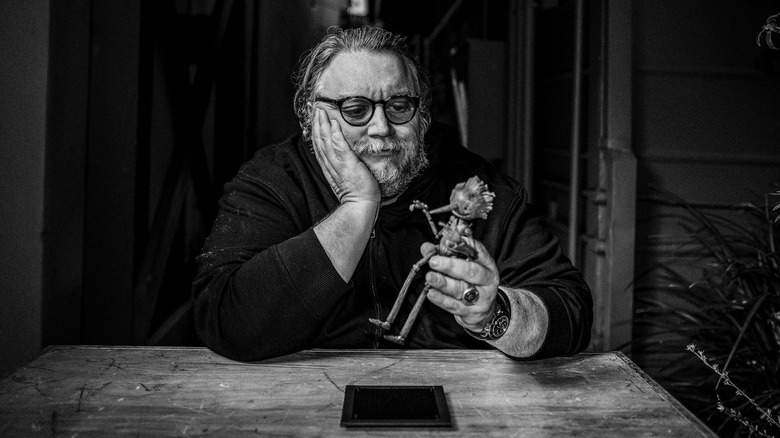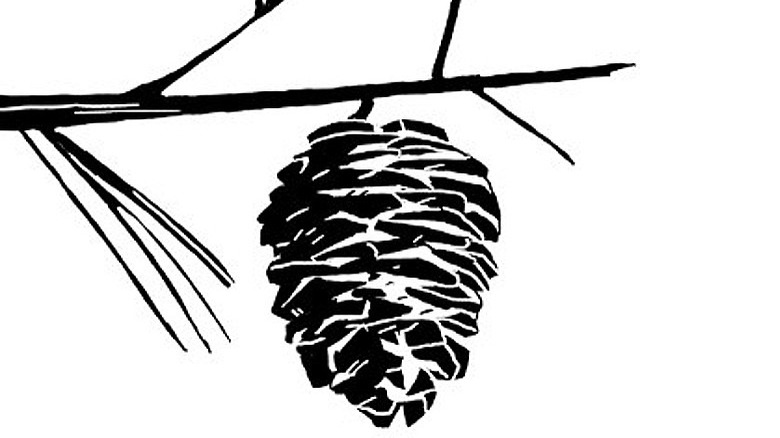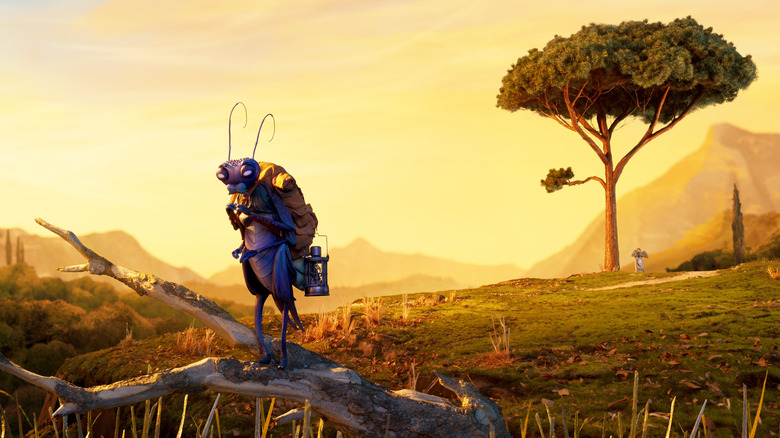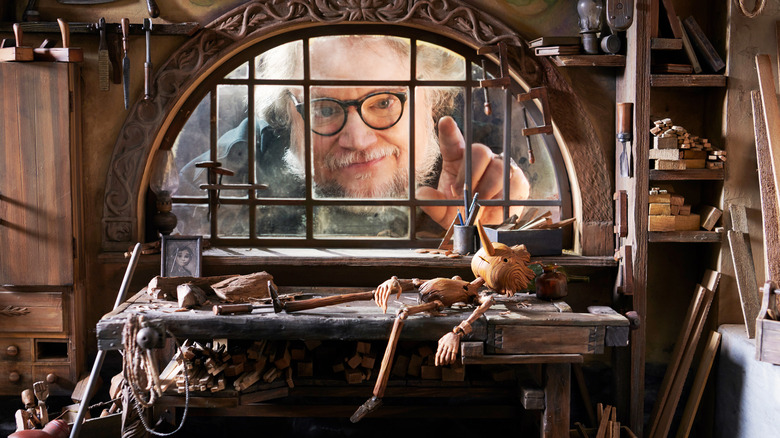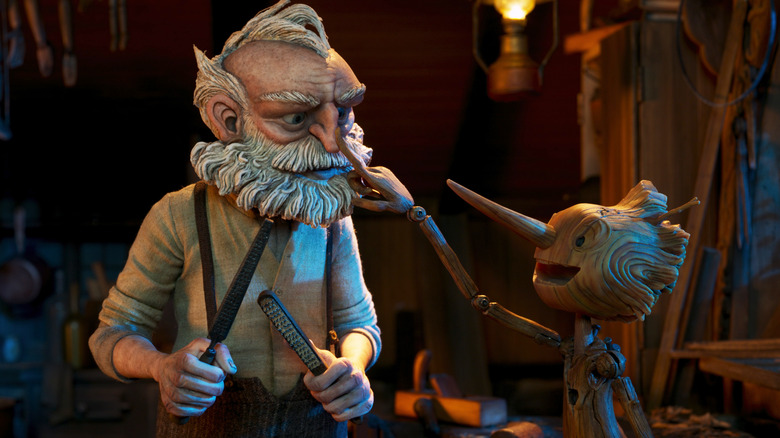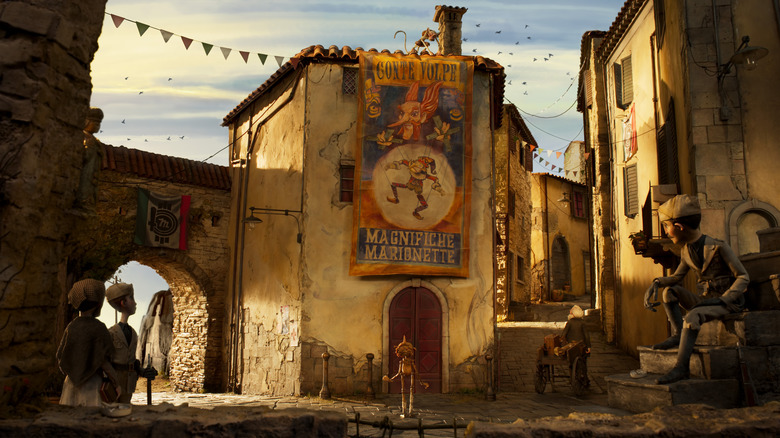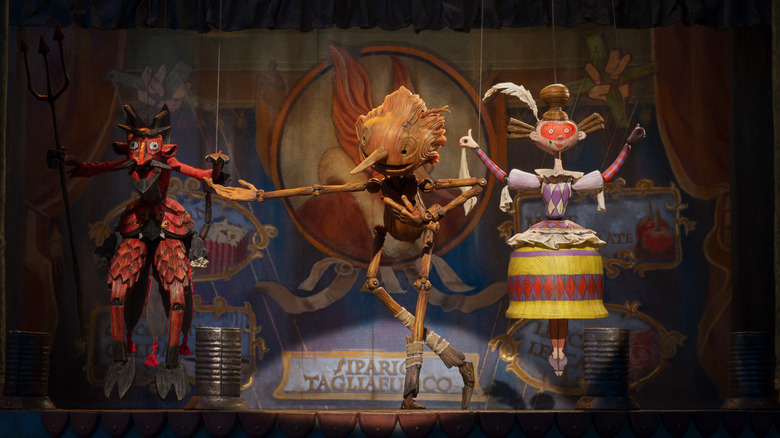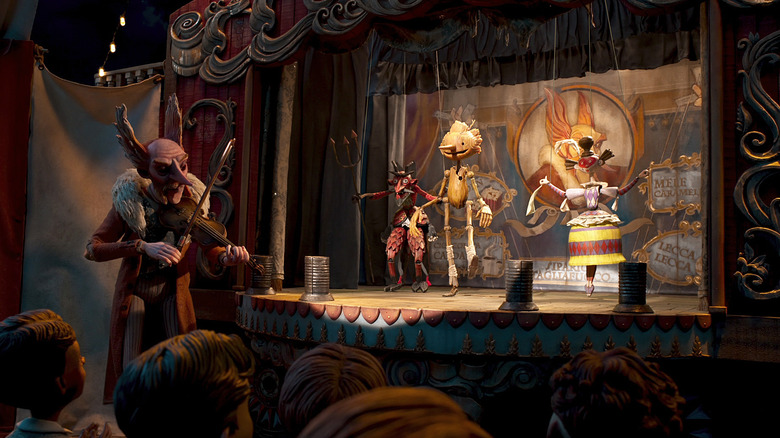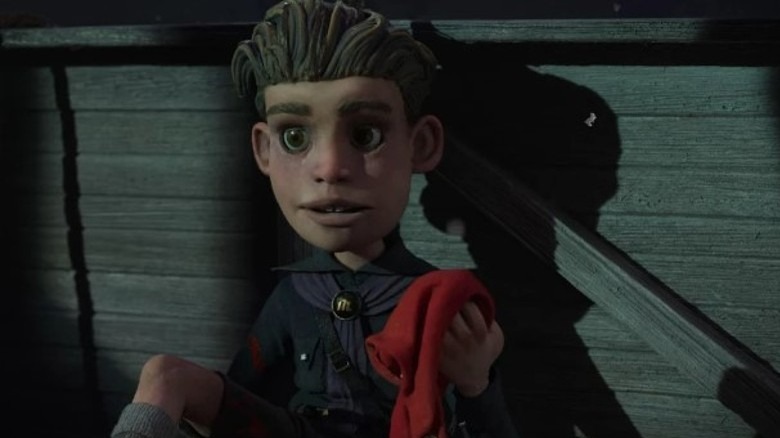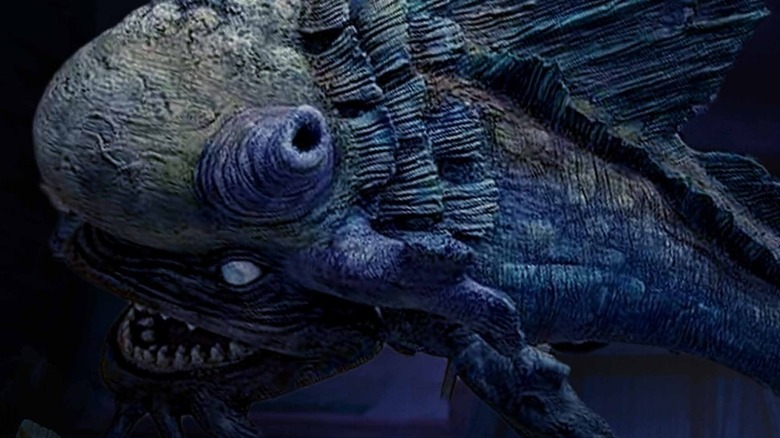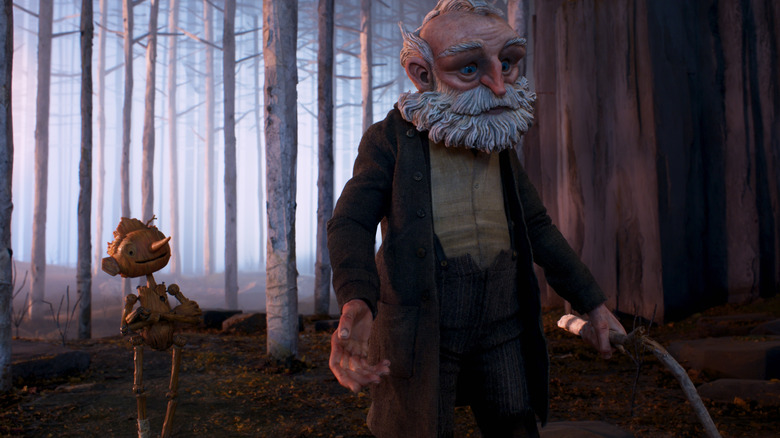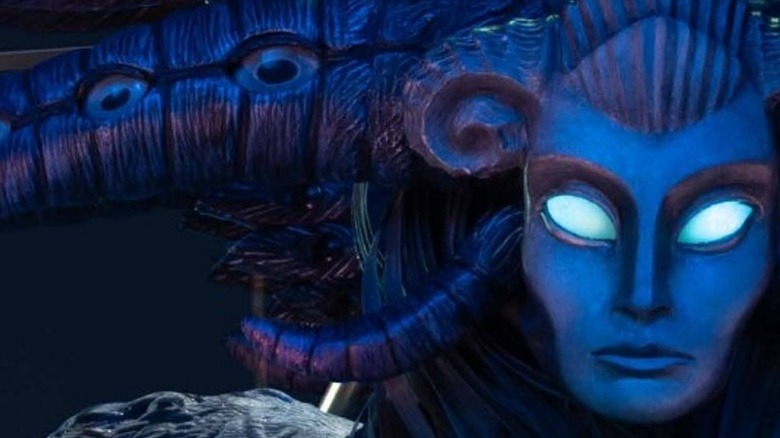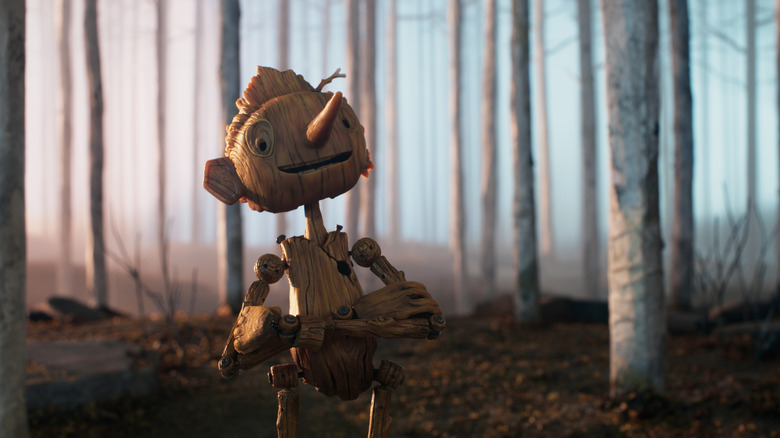7 Best And 7 Worst Moments In Guillermo Del Toro's Pinocchio
This post contains spoilers for "Guillermo del Toro's Pinocchio."
"Guillermo del Toro's Pinocchio" cobbles together the best elements of del Toro's work into a moving, bittersweet stop-motion animated film about the preciousness of life. Fans of the horror maestro's work will find his familiar themes — outsiders, existentialism, anti-war, anti-fascism — take center stage in this magical tale about a wooden puppet (Gregory Mann) destined to heal the broken heart of a grieving man named Geppetto (David Bradley). But unlike previous adaptations, Pinocchio's origin story has more of a Frankenstein's monster feel to him. As Pinocchio learns what it means to be human, the audience becomes tasked with unraveling how humane we are or could be — a compelling premise for all ages.
Co-directed by del Toro and Mark Gustafson and co-written by del Toro and Patrick McHale ("Over the Garden Wall"), "Pinocchio" wastes no time setting up its dark opening. Within minutes, Geppetto's young son Carlo (also voiced by Mann) dies due to an air raid bomb: This specific shot mirrors a similar somber sequence in del Toro's "The Devil's Backbone." Bereft with grief, Geppetto begs a Wood Sprite (voiced by the ever-ethereal Tilda Swinton) to bring his son back to life. Sympathizing with the old puppeteer, the Wood Sprite agrees and puts his son's soul into one of his wooden creations. What follows next is a tearjerking adventure that explores the highs and lows of the human experience. Here, we'll explore the film's grim and hopeful sequences (aka the best and worst moments) in depth while humming Alexandre Desplat's catchy score.
Best: The timing of this film's release
Often in interviews, filmmakers will be asked why they decided to release the film now and how it contends with what else is happening in the world or in cinema. When speaking about "Pinocchio" to Netflix, Guillermo del Toro underlined how the timing of this film held great importance for him, and his reasoning adds a beautiful additional layer to the hand-crafted animation. "We find ourselves in a world that has become far more complicated in the last few decades and kids now have questions and want to know about things that are really complex," he stated. "Their emotions are very complex. There's a sense that the world needs dialogue about what is true and what is a lie, what are the ties that bind families, and what it is to be human and to be alive."
Following Donald Trump's presidency (read: tyrant tirade) that ran on misinformation and fear-mongering, America has been tasked with facing its insidiousness, and parents left the unenviable job of discussing why people lie with their children. When children are growing up, they lie to figure out what the truth means — a big concept for growing brains to digest all the constrictions and possibilities of reality! But how do you explain when lying becomes a choice by adults to harm people when you'll know their inevitable "why" will immediately follow? Although this film doesn't fully answer this question per se, it admirably begins these conversations for families.
Worst: The pine cone imagery
When I say it's the worst, I mean I sobbed every time I saw a pine cone on-screen. The film opens and ends on the same shot: a pine cone. In the film, this image represents life and death. Geppetto's son dies because he ran back into the church to find his pine cone. The air raids above dropped a bomb to lessen their cargo hold, sending it right into Carlo's path. After the church explodes, all Geppetto has of his son to bury is his pine cone. The film tenderly shows this action with the most heartbreaking narration: "The world moved on, but Geppetto did not." He grieves nightly against a pine tree.
But then Geppetto builds Pinocchio out of an Italian pine tree in the woods his son played in with him. Metaphorically, Geppetto building with the pine and creating something anew in honor of his son reminds us our creations and artwork immortalize those we've lost in life. When Pinocchio lies and his nose grows, at times, so do pine cones. Although the film never confirms it to Geppetto, the audience knows that it's most likely that the Wood Sprite borrowed Carlo's soul to put into the puppet. While Pinocchio is still a unique creation, he sings songs only Carlo knew. When we see the pine cone sprout on his wooden nose, it feels like a reminder that a part of Carlo lives on with Pinocchio.
Best: Sebastian J. Cricket's homewrecking scene
Yes, the film spends its opening act amidst a grieving Geppetto. But that doesn't mean it doesn't interweave good ol' fashion slapstick comedy into its story. One of the best times the film pulls this off is when we meet Sebastian J. Cricket's (Ewan McGregor), a scene that will likely play slightly differently for younger audiences. After drinking a bottle of alcohol, Geppetto drunkenly gets to work crafting Pinocchio out of pine. Unbeknownst to him, that's also aspiring novelist Cricket's home! With each slash of the knife, Cricket gets dangerously close to losing an antenna. Thankfully, the precocious pest survives the ordeal — but not before Geppetto destroys his well-furnished home. Each drunken bob, weave, and stumble adds some much-needed reprieve after grappling with watching a man outlive his child.
However, the joy of this scene truly comes from McGregor's zestful portrayal. He imbues the character with such indignation that feels appropriately silly and lightens the tone whenever it steers into the too-grim territory. As a creator who loves creatures, it's such a Guillermo del Toro move to give the side bug character a fleshed-out backstory, hopes, dreams, and attitude. The fact that Cricket gets roped into looking after Pinocchio and Geppetto to secure a massive future book deal will earn some chuckles from adult viewers — especially the artist ones.
Worst: Candlewick's desire to burn Pinocchio alive
Sure, kids sometimes pull pranks on each other. But I did not expect Candlewick (Finn Wolfhard) to trick Pinocchio into putting himself on fire. At first, when Candlewick asks Pinocchio to sit closer to the fire, it feels like some morbid curiosity at play. Maybe Candlewick wasn't sure if he could die? But soon enough the request gets fairly dark, as the oblivious Pinocchio's feet go up in flames. When Pinocchio realizes his feet are on fire, Candlewick laughs. Considering his father Podestà (Ron Perlman) is a fascist war-hungry character, this moment is definitely showcasing some inherited ideas on violence.
Candlewick wants to make his father proud: He knows his father detests Pinocchio. Why? Pinocchio asks questions. Pinocchio doesn't like to follow others' rules without knowing why they exist. When he does as he's told — like in this scene — he often faces dire consequences. He's the living embodiment of independent thinking and intellectual freedom that Podestà wants to suppress in Italy. Seeing Candlewick go to such extreme lengths to please his father is harrowing, as it's a reminder that to be loved, our children can commit harm. It's our job to teach them a more humane way of being.
Best: Cricket's pep talk on a father's despair
Cricket is on this list a lot, as he deserves to be! At the start of "Pinocchio," Cricket is a self-absorbed creature. By the film's end, he's a loving and supportive force for Pinocchio. What makes Ewan McGregor's performance work is how sweetly he delivers pep talks to the wooden boy. Disney's 1940s "Pinocchio" had a Jiminy Cricket who scolded Pinocchio when he misbehaved. Patrick McHale and Guillermo del Toro's writing creates a character who understands how strange and confusing the world looks from a child's perspective. The best example of how they accomplish this is Cricket's speech about empathy, which comes after Geppetto snaps at Pinocchio and calls him a "burden."
Although Gepetto is happy to have Pinocchio around, he still misses Carlo. He struggles to explain grief to Pinocchio, as he's never seen someone he loved die. Sometimes, Pinocchio's obliviousness hurts Geppetto's feelings. Cricket explains to Pinocchio that sometimes fathers will say things they don't mean when upset, and that's because even fathers can feel despair. He doesn't excuse Geppetto's actions but teaches Pinocchio a valuable lesson: Fathers are not perfect as people are not perfect, but that doesn't mean they love you less.
Worst: Leaving Carlo's book behind
One of the film's more heartbreaking moments is when Pinocchio leaves behind Carlo's old school book. Geppetto gave Pinocchio that book so he could go to school. Of course, the whimsical Pinocchio gets distracted and finds himself being a headlining act at a carnival instead. Later in the film, Geppetto finds the ruined book and yells at Pinocchio. Yes, he was upset that Pinocchio ditched school. But what was more upsetting for his father was seeing one of Carlo's possessions ruined. Given how his son died, whatever remains he has of him are precious. Discarding the book is analogous to throwing away his memory.
Deep down, Geppetto knows this wooden puppet is not the same Carlo, and this moment is a painful reminder of who he lost. But Geppetto forgets that for Pinocchio, the book is just a book — a sentence to do multiplication (gross!). He's still learning how to understand other people's emotions while feeling his new feelings, and this dichotomy fuels their fights. Thankfully, we have Cricket's moving line to help Geppetto out: "See the love that you have and don't be overwhelmed by mourning."
Best: Anti-Mussolini play
"Big Baby Il Duce March" epitomizes the boyishness of Pinocchio. The wooden boy has so much glee and immature rebellion that he doesn't quite understand that his story is happening amidst WWII in Italy. Of course, he thinks it'd be a perfect idea to use his center-stage act to essentially call Mussolini a poopy head! He doesn't think about the consequences of his actions at all. In his mind, he sang the "Fatherland March" fascist hymn enough. Geppetto told Pinocchio that "war is not good, war is what took my Carlo away," so Pinocchio decides to spread this message to Mussolini directly. Why not!
Before its bloody aftermath, the "Big Baby Il Duce March" is delightful to watch. Not only are the lyrics bound to make the eight-year-olds (and their guardians) laugh, but it's also a great example of seeing Pinocchio take a stance. He's learned enough about what's happening in the world to condemn Mussolini for sending young boys like Carlo into warfare's dangerous path. He doesn't want to be a puppet in a propaganda machine: He wants to spread joy. Considering the research Patrick McHale did on jingoistic songs from the WWII era (according to the movie's press material), this hymn likely gave the cast and crew some much-needed levity too.
Worst: Mussolini kills Pinocchio and explodes a carnival
Although Guillermo del Toro's films delve into whimsy, they never overlook depicting the consequences of our actions. What does Pinocchio get for rebelling against Count Volpe (Christoph Waltz)? Mussolini shoots Pinocchio. But even before that, the audience hears something even more harrowing: Mussolini is so upset by the "Big Baby Il Duce March" song, he orders his men to set the carnival on fire. The scene then cuts to Pinocchio in the underworld, so thankfully we don't see a mass murder play out in stop-motion animation. However, the audience can still imagine it.
Keeping this dire turn in the film works well, as it shows how, unlike Geppetto, men like Mussolini have no regard for human life if it affects their status. The only downside to this scene is we never see Pinocchio fully understand how his cheeky song about slime and poop affected others at the carnival. Likely, that would have been a bit too heavy for this film, especially considering we see a group of grade-school-age boys head off to war.
Worst: Candlewick faces off against Podestà
Throughout the film, Podestà has it out for Pinocchio, going so far as to convince his son that he has to kill him. He wants Candlewick to believe that Pinocchio — and all he represents — isn't right or real. When the three of them are training at a war camp, Podestà says that these boys have "the hearts of men," oblivious to the fact that they're more or less canon fodder for the Axis powers. After Candlewick's father orders him to shoot Pinocchio, he says, "I'm not afraid to say no."
Sadly, this act of defiance doesn't go over well. His father essentially calls him worthless, deeply upsetting him. A son should never have to do everything their father asks just because they ask to do it — especially not when it's murder! Watching Candlewick grow into a more confident and independent thinker carries deeper meaning too: Symbolically, it represents the children and future generations of Italy who rebelled against fascism, even if it cost them their families.
The only bright side to this heartwrenching scene is that it gives Pinocchio a chance to give Candlewick the "father's despair" speech. He reminds Candlewick that he's loved and even fathers make mistakes.
Best: Dogfish's design
In the original film adaptation of "Pinocchio," the belly of the whale scene is probably its most iconic shot. Choosing to also have Pinocchio, Cricket, Geppetto, and the surprise addition of Spazzatura (Cate Blanchett) escape a dogfish's stomach put a lot of pressure on the sequence to live up to that memorable outing. To the entire team's credit, it does!
The dogfish, in particular, is a moody and gorgeous rendering of stop-motion animation that feels haunting and desolate simultaneously. Production designer Guy Davis based the ravenous creature on sea serpents. "It's a creature that's trying to eat everyone, but it's lived so long that it's just bored and miserable," Davis said. "I wanted it to have a little bit more character than to just be a mindless killing machine going through the ocean."
The interior of the dogfish feels sticky and a bit rotted — as it should for an animal consuming so much meat. Although the escape-via-sneeze scene is expected, the texture of the creature keeps it compelling and lovingly strange. You can smell and feel the wretched breath.
Worst: Pinocchio sacrifices his life for Geppetto
After the gang daringly escapes the dogfish, they contend with surviving on the open seas. Initially, Pinocchio does not survive. Death instructs him to wait for the sand in his hourglass to run out before he can return to life. However, Pinocchio decides he won't wait, as he doesn't want to risk Geppetto dying. Death tells him to "break the rules if you're sure," with the caveat that if he dies this time, there is no more resurrection. His choice to return to life for his father marks his growth, as he is putting someone else's needs in front of his own.
Despite losing an arm, Pinocchio pulls Geppetto to safety. But the sequence of him pulling Geppetto goes on a little longer than you might expect. From time to time, the duo sinks deep enough that you fear they're dying. The push and pull of the current feel real on-screen, as does the physical effort of Pinocchio lifting Geppetto — a stunning feat for stop-motion animation. In the end, Pinocchio dies. We see Geppetto lift his lifeless collection of sticks, and your heart breaks at the unfairness of him losing his son twice in his lifetime.
Best: Tilda Swinton as Death
Tilda Swinton imbues warmth and kindness into her angelic Wood Sprite role. But her turn at Death is perfection; calculating, a little bored at being around until the end of time, and regal. She is the character who teaches Pinocchio a harsh truth about life: everyone else only gets one turn at it. However, Pinocchio will have to live life again and again. She warns him that this will be harder than he thinks. At first, Pinocchio thinks eternal life is a game of sorts — living forever, taking risks without worrying about the fallout. But when his recklessness puts Geppetto in danger, he realizes he has been focusing on himself at the cost of hurting others. Death knows this and gently guides him into seeing his selfishness.
In the film's production notes, Guillermo del Toro describes Death as something other, not flesh and blood. Her wings with eyes on them came from Mexican angels in medieval paintings. Guy Davis likens her to a "goddess" with Sphinx-like energy, which matches well against Swinton's cautious and yet taunting tones. Swinton gives one of the most convincing interpretations of death in cinema.
Best: Pinocchio never becomes human
For Guillermo del Toro's "Pinocchio," he wanted to make one vital change, according to the movie's press material: At the end of his film, Pinocchio would not turn into a real boy. He would stay a puppet and Geppetto would learn that children are allowed to change and grow. When del Toro read Carlo Collodi's "Pinocchio," he didn't like its underlying message, stating to Netflix, "So, it means to be loved, you have to change? I couldn't accept that." The goal of this film is for Pinocchio and Geppetto to learn the healing power of love and acceptance, which counters the film's focus on the oppressiveness of fascism.
While Geppetto starts the film berating Pinocchio for not being like Carlo enough, he ends it with the loving line: "Be exactly who you are. I love you exactly as you are." Having Pinocchio return to life as a puppet works well in the film because it lets us watch this iteration of him mature through time. He doesn't have to become anyone other than himself. That's a lovely message for children to hear — especially after seeing how demanding and cruel Candlewick's father could be.
Worst: Not enough Spazzatura!
Animated movies are incomplete without a fuzzy little animal companion to help the main character's journey. For "Pinocchio," we get the hijinks-loving Spazzatura! Initially, I couldn't believe Cate Blanchett voiced the role; not because she doesn't have the talent to, but because it sounds nothing like her. Even great voice actors sometimes throw a hint of their natural cadence or accent into the role. But I 100% bought that Blanchett evolved into a sassy monkey! She has very little dialogue in the film, so she has to rely on grunts, grimacing sounds, and squeals to convey the character's emotion, which she does well.
Like Candlewick, Pinocchio inspires Spazzatura to rebel and break free from her abusive owner. She refuses to be controlled anymore by an oppressive force — one of the film's central themes. In the film's final act, we see Spazzatura join Pinocchio, Geppetto, and Cricket and eventually move in together to live out the rest of their lives. However, we don't see much of their lives after their big adventure, as the film opts to show us a montage instead, giving us glimpses into their home life. I wish we could have seen her happy life a little more, considering how she was a mistreated carnival animal for most of her life. But as the film so aptly reminds us, we only have the time we have, and that has to be enough.

